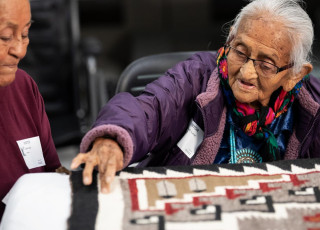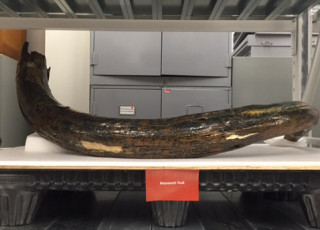The Museum's Wall of Wonders
By Riley Black
Stroll into the Natural History Museum of Utah, your footsteps echoing off the Canyon walls, and you’ll be greeted by a stunning surprise. Encased in glass, rising 36 feet into the air, is a swirling collection of specimens. There are dinosaur tracks, reptiles in jars, Native American artwork, butterflies, and more, just a whisper of the millions of specimens that make up the heart of the Museum. This is the Collections Wall, a bridge between what you see when you visit and the research that is constantly unfolding behind the scenes.
Museum designers took that connection literally. When the Museum’s Canyon was being planned, museum staff worked with designers to create something that would be a literal interface between what you can see in the exhibits and the research that realizes the museum’s mission. That’s why the Collections Wall stands where it does. The south side, facing outwards, represents the exhibit spaces, while the north side is set against the side of the museum that houses collections and offices. The Collections Wall sits right at the connection point between these two museum worlds.
Pulling off this piece of art was no easy task. The design called for over 600 individual objects to be suspended in a way that would both be visible to guests, safe for the specimens, and pleasing to the eye. More than that, the exhibit designers wanted to represent all the different fields of study – or -ologies – active at the Museum. Some specimens were mounted with steel, others with brass, but all were carefully selected and cradled in specially-made mounts to keep the items safe while also showing them off.
The emerging picture is of the museum’s varied research interests, from dinosaurs to Native American cultures, all centered around a colorful swirl of shells and butterflies. Those beautiful insects, in particular, come from a huge collection of preserved butterflies donated to the museum by the Pearce family, further underscoring the connection between the public and the experts who work at the Museum.
Just like the research going on at the museum itself, what’s on display on the Collections Wall changes. That’s because some of the pieces on display – especially masks, rugs, and other pieces of art from the Anthropology collection – are sensitive to light. Museum curators switch out some of these delicate items about every five years, with the last reconfiguration taking place in November of 2016. In a few years, museum experts will go back to the wall to give it a whole new look.
Take a moment to stop and think about that the next time you visit the museum. The Collections Wall presents hundreds of astonishing items, it’s true, but the splash of scientific color is much more than the sum of its parts. Each piece is part of a connection between the two different faces of the museum – the care and study of what the Museum collects, and how those finds are translated to you in the galleries. Take a breath, let your eyes wander, and see which stories speak to you.
Riley Black is the author of Skeleton Keys, My Beloved Brontosaurus, Prehistoric Predators, and a science writer for the Natural History Museum of Utah, a part of the University of Utah in Salt Lake City. Our mission is to illuminate the natural world and the place of humans within it. In addition to housing outstanding exhibits for the public, NHMU is a research museum. Learn more.



